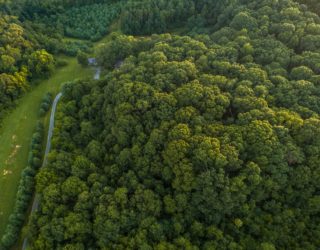Working towards the UK Government’s Environment Improvement Plan 2023
At the end of January, the UK Government published its Environment Improvement Plan 2023 (EIP 2023). This is the first review of the 25 Year Environment Plan (25YEP) that was published in 2018 and sets out the steps needed to deliver on the original framework and vision for nature recovery.
The government’s apex goal is to achieve ‘thriving plants and wildlife’. This is underpinned by further goals to improve environmental quality, resource use, mitigation of climate change and biosecurity.
With broad coverage and ambitious goals, the plan will undoubtedly touch all of us, professionally and personally, as society moves to become more sustainable. In this blog, we look at the eight key policies that will deliver the apex goal and how Thomson are currently supporting partners to deliver on them.
1 – Promote Biodiversity Net Gain, and make sure developments leave habitats in a better state for wildlife than before.
The requirement for Biodiversity Net Gain (BNG) on developments isn’t a new concept but from November 2023 will become mandated through the Environment Act 2021. This will mean most new developments will have to demonstrate a minimum 10% biodiversity net gain as part of their planning submission. In this way, any new development will make a contribution to the government’s nature recovery targets.
Many of our clients in the residential and commercial development sector, and rail and highways, have already introduced BNG into their operations. We support these by conducting baseline biodiversity assessments using tools such as DEFRA’s Biodiversity Metric 3.1, and prepare BNG strategies for clients looking at both on-site and off-site enhancements. Whilst still in its infancy, we can already see the positive impacts that BNG is having, with many clients already looking to go beyond the mandated 10% improvement.
2 – Create, restore and extend up to 70 areas for wildlife.
Creation, restoration and extension of habitats includes those currently outside of protected sites, and bring sites of special scientific interest (SSSI) into favourable condition. There are constraints and opportunities here for institutional landowners, local authorities and non-governmental organisations. We have already seen major infrastructure projects engaging in significant habitat creation and restoration works, and Thomson has worked with them directly to deliver positive environmental legacies.
Under this creation and restoration goal is a target to increase tree canopy and woodland cover. On top of the obvious benefits for wildlife and people, planting schemes offer additional benefits through carbon sequestration, with growing trees absorbing and locking away CO2.
We work with public and private sector clients planting hundreds of acres of woodland supporting ‘green corridor’ and ‘trees for climate’ schemes. Our habitat management team use their expert knowledge to carefully select the optimal tree species for landscape and habitat continuity, functionality and amenity value, and resilience and longevity in the future. Thomson also supports clients in response to the declared climate emergency with tree canopy mapping in urban and peri-urban areas. Canopy mapping identifies locations for ‘infill’ planting to maximise tree cover and carbon sequestration opportunities. Our ability to deploy machine learning and artificial intelligence on mapping projects enhances value for money for clients and speeds up delivery times.
3 – Support the adoption of nature friendly farming.
With around 69% of land in England used for agriculture (DEFRA, 2022), it is no surprise that major policy commitments are targeted in this area. Evolved agricultural payment schemes, sustainable farming incentives and contribution to landscape recovery projects all feature.
Conservation covenants, a new kind of legal agreement between landowners and designated bodies, also seek to contribute. These covenants will secure benefits for conservation or heritage features for the long term. Indeed, they will play an important role in securing offsite biodiversity gains where onsite gains cannot be realised.
Thomson has been involved in monitoring the success of national agricultural payment schemes for the Welsh Assembly Government. The Tir Cynnal and higher level Tir Gofal schemes focused on protecting and enhancing important habitats on farm holdings. Thomson undertook habitat surveys and species monitoring to evaluate the schemes’ success and report the outcomes to government.
4 – Launch the Species Survival Fund to create, enhance and restore habitats.
With priority species abundance declining 2% every year, a multi-million pound Species Survival Fund seeks to protect and restore habitats which will help halt the decline of species. Species Conservation Strategies (SCS) will find better ways to protect species at risk and improve their conservation status. Initial pilots will focus on hazel dormouse, water vole and widespread reptiles.
Thomson has over 20 years’ experience as a leading specialist environmental consultancy, working with clients to avoid, mitigate and compensate for impacts on species and their habitats. We have a team of protected species specialists who hold associated licences and accreditations. Our experience includes some of the country’s largest mitigation schemes including habitat creation and species translocation.
5 – Map wetlands and the actions needed to protect these habitats.
Wetlands are a hugely important habitat, covering about 2.8million hectares in the UK. Whilst they make up just 3% of the UK, they account for around 10% of all our species. Wetland habitats are not just crucial for wildlife, they also offer a multitude of other benefits such as nutrient removal and carbon sequestration. However, they are threatened by development, recreation, changing agricultural practices and climate change. The government plan seeks to develop a UK wetland inventory, mapping the location and extent of UK wetlands and then identify actions needed to protect them.
Our freshwater ecology team are engaging with clients in a variety of sectors to identify and find solutions to potential impacts on wetlands. Our experts can advise on a catchment based approach to water quality and use of nature based solutions. We also offer modelling to assess loads and sources of nutrients and contaminants that are impacting on wetland habitats and the species they support.
6 – Invest in solutions that protect and restore global nature.
The EIP23 doesn’t just cover actions being taken at home. The plan also sets out how the UK government will invest at least £3 billion of International Climate Finance (ICF) on climate solutions involving the protection and restoration of nature. It also seeks to unlock private finance alongside other nations to bridge the $700billion per year finance gap for global nature recovery.
7 – Support Marine Protected Areas to be in favourable or recovering condition.
The UK government has already established some 35,000 square miles of marine protected areas (MPAs) in English waters. By 2028, the aim is for 48% of designated features in these MPAs to be in favourable condition.
The plan recognises the importance of marine development and facilitating the diverse use of our sea and coast. However, this must be done whilst protecting key marine habitats and species. The plan sets out aims to optimise the use of marine space through Marine Spatial Prioritisation schemes, how the government will monitor and report against marine plans and how it will work to develop a sustainable ocean economy.
Part of that ocean economy is offshore wind. This is a critical form of renewable energy and a priority to support the UK’s transition to net zero and ensure future energy security. Offshore wind provides opportunities for the creation of artificial habitat for marine wildlife. However, there are risks of negative environmental impacts during the development stages. Recognising that progress must be made whilst avoiding environmental risks, the government points to the British Energy Security Strategy that seeks to implement faster consenting for offshore wind developments whilst maintaining high levels of environmental protection.
Our marine ecology team have been operating in the marine sector for over 30 year. We help clients obtain licences and consents for offshore renewable energy, decommissioning, and other marine constructions. We also offer consultancy for navigational dredging and disposal operations, beach recharging, aggregate extraction and all near-shore developments.
8 – Create Highly Protected Marine Areas to allow sites to fully recover.
Alongside MPAs, there are proposals to create Highly Protected Marine Areas (HPMAs). These are areas of the sea (and shoreline) with high levels of protection that will allow the full recovery of marine ecosystems. These sites will contribute to 30 by 30 targets (a global target to protect 30% of the planet for nature by 2030) and increase resilience to climate change. The government is intending to designate the first HMPAs this year.
As with any plan, the monitoring of actions to determine success will be critical. The government has committed to eight marine monitoring objectives as part of their Outcome Indicator Framework. Three of these focus on monitoring of seabed habitats and associated species such as shellfish populations. Thomson are leading experts in monitoring seabed habitats with a dedicated marine laboratory conducting macrobenthic faunal analysis and particle size analysis. This capability allows us to support a wide variety of projects and monitoring programs in the UK and overseas.
What’s next for nature?
The commitments made in the Environment Improvement Plan are significant and if implemented, would see progress being made to reverse the decline of nature. The ambition is clear and we know that amongst our partners and customers, there is a desire to go beyond mere compliance, and deliver positive outcomes for the environment. There is much work to be done, but we at Thomson environmental consultants remain committed to supporting our clients, enabling business and nature to thrive together.
References:
DEFRA (2022). Agricultural land use in England at 1 June 2022. DEFRA. Available at: https://www.gov.uk/government/statistics/agricultural-land-use-in-england/agricultural-land-use-in-england-at-1-june-2022#:~:text=The%20utilised%20agricultural%20area%20(UAA,4.9%20million%20hectares%20in%202022.
DEFRA (2023). Environmental Improvement Plan 2023. DEFRA. Available at https://assets.publishing.service.gov.uk/government/uploads/system/uploads/attachment_data/file/1133967/environmental-improvement-plan-2023.pdf
DEFRA (2018). A Green Future: Our 25 Year Plan to Improve the Environment. DEFRA. Available at: https://assets.publishing.service.gov.uk/government/uploads/system/uploads/attachment_data/file/693158/25-year-environment-plan.pdf











